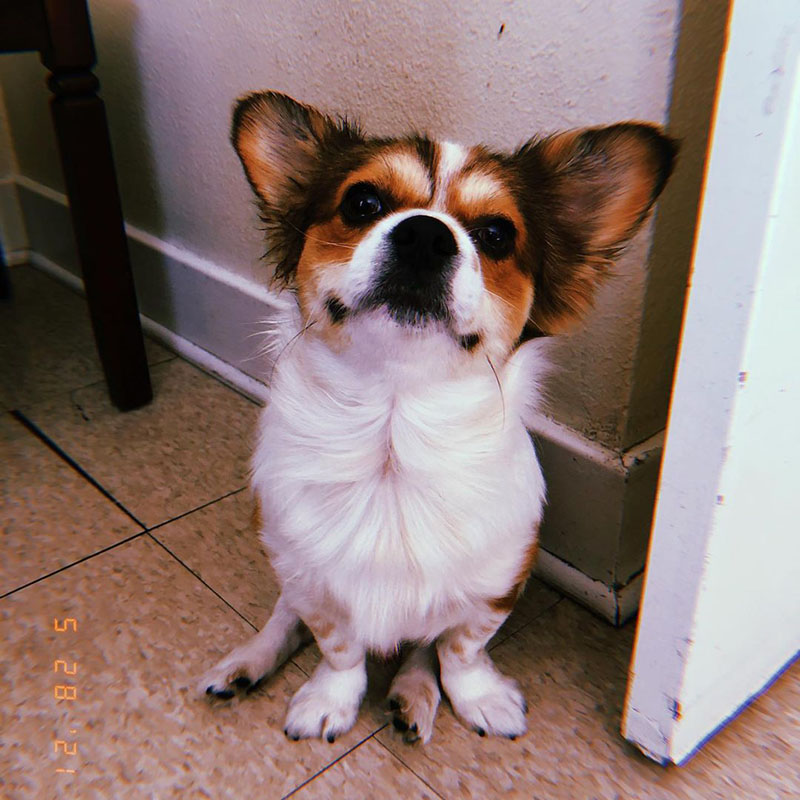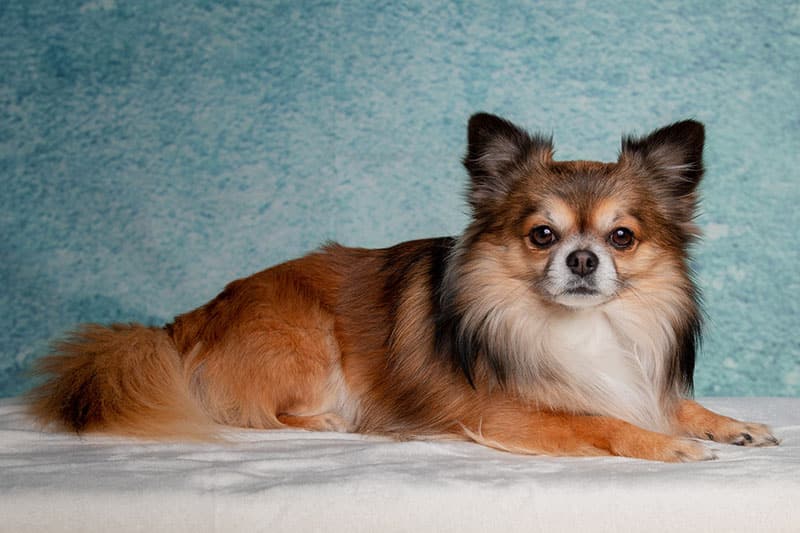The Corgi Papillon mix is an adorably small mixture of the Pembroke Welsh Corgi and the Papillon. These two parent breeds act like lapdogs and will produce an energetic, spry, spunky little dog with plenty of attitude, stubbornness, and an endearing personality.

The “Corillon,” to give it another name, is a popular Corgi mix due partly to its size, making it the perfect fit for a family pet or as an elderly person’s companion pet. This mixed breed dog typifies the “all bark, no bite” personality-type – while it may appear aggressive and standoffish, it’s perfectly harmless and will warm up to strangers quickly.
The Papillon Pembroke Welsh Corgi mix is a relatively new mixed-breed dog, appearing sometime in the 1990s and early 2000s. We’ll explore their parent breeds to learn more about the Papillon Pembroke to give you a better idea of what to expect if you’re looking to adopt or purchase this adorable mix.
Corgi Papillon Mix – At a Glance
| Weight: | 15 – 25 pounds |
| Height: | 8 – 11 inches |
| Lifespan: | 10 – 14 years |
| Coat Colors: | White, black, tan, a combination of two or three colors |
| Temperament: | Energetic, affectionate, loyal, loving, spry, sociable |
| Most Suitable For: | Active families, single individuals and the elderly |
What Does a Corgi Papillon Mix Look Like?

As with many designer breeds, the Corgi Papillon mix will inherit its physical appearance from each parent breed. The Corgi Papillon will likely inherit the smaller frame of the Papillon, with the elongated body of the Pembroke Welsh Corgi. It may also inherit the Corgi’s classic upright ears, though they may be pointed rather than rounded.
You can expect the Corgi Papillon to have almond-shaped eyes, like the Papillon, and the shorter legs of the Pembroke Welsh. It will likely have a broad chest and may or may not have a docked tail. Regarding coat colors, your Corgi Papillon mix may inherit either the black or tan primary color but will almost always have white markings, typical of the Welsh Corgi.
Are you looking for a way to treat your furry friend? Sign up for our newsletter for a chance to win a free month of Barkbox!
The History of the Corgi Papillon Mix
The history of the Corgi Papillon mix is unfortunately a short one – not much is known about when this dog came to be or who first bred a Pembroke Welsh Corgi and a Papillon.
The popularity of crossbreeding in the United States first began in the 1990s and early 2000s. The practice had come about during the 1960s but hadn’t caught on till the 1990s, when everybody and their mother was crossbreeding dogs of various sizes and types, looking for the most interesting cross breeds. Depending on the breeder, there are practical reasons to crossbreed one dog breed with another, so be sure to look for a reputable breeder when adopting or purchasing any mixed-breed dog!
To learn more about the history of the Corgi Papillon mix, let’s look into the history of both parent breeds to give us a better idea of why anyone would want to cross a Pembroke Welsh Corgi with a Papillon.
The History of the Papillon

The Papillon is an ancient breed – while not quite as old as the Pembroke Welsh Corgi, its history dates back to the 16th century, when dogs resembling the Papillon were illustrated in Italy. The Italian Renaissance painter, “Titian”, was one of the first to paint the Papillon in “Venus of Urbino” (1542). Papillion’s were famed for being royal dogs, and were owned by such figures as Marie Antoinette, King Louis XIV of France.
Renowned as loyal companions with an affectionate nature, the Papillon quickly gained popularity in France and much of Western Europe. Being toy companion pets, they resembled the Charles Spaniel and were often thought of as the French equivalent of them.
The Papillon arrived in the United States in the early 20th century and was first recognized by the American Kennel Club in 1935.
How Popular Are Papillon in the United States?
After their recognition, the Papillon slowly gained popularity as loyal companion pets. Sized suitably for the elderly and those living in apartments, the Papillon is one of America’s most popular lapdogs.
In 2021, the Papillon ranked as the 54th most popular dog in the United States, according to the American Kennel Club.
Who Are Papillon a Good Dog For?
Given their small size and weight, Papillons are often the first choice pets among the elderly and those living in apartments. Their loyal nature, silky coat, and moderate energy level make them immensely popular.
The Papillon is also a fine choice for those looking for a family pet. Despite their size and ‘small, yappy-type dog’ nature, the Papillon does tend to get along well with other pets and small children.
How Did Papillon Come About?
The Papillon’s precise origins are unknown. However, they were illustrated in the early 16th century by various Italian Renaissance painters and are thought to have originated in France. They have a long history as companions of royalty, from Marie Antoinette to various French kings.
Classified as a toy breed, the Papillon is a companion dog.
When Did We First Cross-Breed The Papillon?
As an ancient breed, the Papillon has likely been crossbred many times without documentation being kept – although it is a rather popular mix breed if an unusual mix breed dog due to its size and curious physical appearance as a drop-eared breed.
Despite the long history of the Papillon, when it first became part of the designer dog breed trend is unknown. However, it has spawned several popular crosses. These include:
- Dachshund Papillon Mix (Papshund)
- Labrador Papillon Mix (Labrillon)
- Poodle Papillon Mix (Papoodle)
- Shepherd Papillon Mix (Shepillon)
- Spaniel Papillon Mix (Spanillon)
The History of the Corgi

The Welsh Corgi’s history dates back to the 12th century when it arrived in Wales from Flanders (modern-day Belgium) with Flemish weavers, who migrated to Wales and settled in Pembrokeshire. Their settlement here gave the Welsh Corgi the name “Pembroke Welsh Corgi.”
Originally used as herding dogs, the Pembroke Welsh Corgi aided their Flemish masters in herding sheep and other small cattle. Unfortunately for the Pembroke Welsh Corgi, it was gradually replaced as a herding breed by bigger, stronger dogs as the centuries progressed.
Despite their replacement as a herding breed, the Pembroke Welsh Corgi found new favor, with royalty! Queen Elizabeth II had a strong love for her Corgis, and owned more than thirty during her lifetime. She was even responsible for the creation of a Corgi mixed breed! (More on that later).
The Pembroke Welsh Corgi has a cousin – the Cardigan Welsh Corgi – this Welsh Corgi was developed in Cardigan, Carmarthenshire, Wales. The Cardigan Welsh Corgi has a slightly different color pattern to the Pembroke Welsh and stands 10 – 12 inches tall. Like its Pembroke neighbor, the Cardigan Welsh is renowned for its friendly nature, agile body, and being well-suited to apartment life.
How Popular Are Corgis in the United States?
Like in Europe, the Cardigan Welsh and Pembroke Welsh Corgis enjoy very different levels of popularity. The Pembroke Welsh’s popularity in the United States has been boosted by their appearance in Netflix’s “The Crown”.
In 2021, the Pembroke Welsh Corgi ranked as the 11th most popular dog, according to the American Kennel Club. By the same metric, the Cardigan Welsh Corgi unfortunately lags behind in 67th place.
Who Are Corgis a Good Dog For?
Welsh Corgis – whether the Pembroke Welsh Corgi or Cardigan Welsh Corgis are a very popular breed in the United States and Europe, because they fit in so well with almost any household and any family unit.
Their relaxed nature, long life expectancy, low maintenance and moderate need for physical activities make them popular among families and single individuals alike – even the elderly – fit for a Queen, and all that.
Be aware, however, if you have children, your Corgi’s ‘herding’ instincts may kick in, and they may try to ‘herd’ your younglings, which can result in them being a tripping hazard. Learn how to correct this during obedience training.
How Did Corgis Come About?
Welsh Corgis were first brought to Wales by Flemish weavers around 1107 A.D. The weavers left Flanders (modern-day Belgium) for a new life in the Welsh countryside and brought their trusty companion and herding dogs.
As Welsh Corgis were eventually replaced by other dogs for herding purposes, they became steadfast companions of their owners and were eventually companion pets of royalty – being the favorite dogs of Queen Elizabeth II.
Corgis have continued in this fashion as amiable companion pets for years.
When Did We First Cross-Breed The Corgi?
Given it’s history as an ancient breed, the Pembroke Welsh Corgi was likely crossbred many times throughout its history, but no records were kept. However, given its temperament, looks, and popularity, it’s no wonder the Pembroke Welsh Corgi is one of the most popular parents for mixed-breed dogs.
There are many popular Corgi crosses. These include:
- Corgi German Shepherd Mix (Corman Shepherd)
- Corgi Husky Mix (Corgsky)
- Corgi Dachshund Mix (Dorgi)
- Corgi Labrador Retriever Mix (Corgi Lab)
How Important Is a Dog’s Temperament to Your Family?
One of the most important aspects of owning a dog is how it fits into your pre-existing life. Many aspects of your life will change when you own a dog, but what’s important to you should stay, and you should find a way to work your dog into those parts, rather than sacrificing those parts for your dog.
To this end, you’ll want to find a dog of similar temperament to you and your family. That is, he has similar habits, and can partake in the family’s hobbies without too much adjustment. If you like to go the markets on weekends, you’ll want to have a dog that’s good with other people and pets, and good in a crowd. If you like to hike or run, you’ll likely want an active companion that will accompany you on these adventures.
Likewise, if you’re a homebody, you may prefer a dog that’s better-suited to being at home.
For example, a Siberian Husky isn’t going to be happy in an apartment setting – they prefer the great outdoors. Likewise, you’re unlikely to find a Pug happy to run with you at 6 AM.
Finding a dog that’s well-suited for your family unit will make your life and the dog’s life much easier. You’ll likely have to spend less time and money training the dog and reduce the risk of being forced to re-home the animal.
What is the Temperament of the Corgi Papillon Mix?
The Papillon Corgi mix is renowned for being a wonderful family pet. As a lapdog, the Papillon Pembroke Corgi is highly affectionate and attached to their owners. This can mean they’ll suffer from separation anxiety, as is common with their parent dogs. Papillon Corgis can also be fairly energetic dogs and will likely require lengthy walks, mixed with outdoor play.
Papillon Corgis aren’t known for their aggressive behavior, though they can sometimes be standoffish around strangers. Welsh Corgis are known to be a little stubborn sometimes, so you may notice this trait in your Corgi Papillon mix.
Is The Corgi Papillon Mix Friendly?
Yes! Despite their initial standoffishness with strangers, the Papillon Corgi is generally a friendly and affectionate dog breed.
Is The Corgi Papillon Mix Easy to Train?
The Papillon Corgi mix might be a little challenging to train due to their stubbornness and high-energy nature. Despite their status as a beloved breed, you may need to put a little extra time and energy into training.
How Much Can A Corgi Papillon Mix Weigh?
The average weight of a Corgi Papillon mix is between 15 and 25 pounds.
How Tall Can A Corgi Papillon Mix Get?
The average height of a Corgi Papillon mix is between 8 and 11 inches tall.
Similar-Sized Breeds
Given the small size of the Papillon Corgi, there are many similar-sized breeds to this Welsh Corgi mix.
These include:
- Cavalier King Charles Spaniel
- Jack Russell Terrier
- Pug
- Miniature Pinscher
Does the Corgi Papillon Mix Shed?
The Pembroke Welsh Corgi has a double coat that could (and likely will) show up in the Corgi Papillon mix. This will mean that your Papillon Corgi mix will shed moderately throughout the year and require extra brushing. They will likely have an average-length double coat and will require extra amounts of grooming, including weekly brushing.
How Much Exercise Does A Corgi Papillon Mix Require?
As a small breed from two moderately-exercised parents, you can expect your Papillon Corgi mix to require regular exercise. These adorable hybrids will need at least 45 minutes of walking daily, along with games of fetch and such to encourage more active play.
How Long Can a Corgi Papillon Mix Live?
The average life expectancy of a Corgi Papillon mix is between 10 and 14 years.
What Health Conditions Could the Corgi Papillon Mix Have?
- Hip Dysplasia (Hip joint inflammation)
- Legg-Calve-Perthes Disease (Developmental orthopedic disease)
- Von Willebrand’s Disease (Blood disorder)
- Patellar Luxation (Kneecap dislocation)
- Cataracts (Eye condition)
How Can You Find a Corgi Papillon Mix Puppy For Sale?
Before looking into finding a Papillon Pembroke mix puppy for sale, we recommend adopting a Papillon Pembroke Welsh Corgi mix. Many dogs, such as the Papillon Corgi mix, languish in animal shelters and vet clinics across the country, placed there by breeders or families who didn’t want them.
There are likely hundreds of such dogs in shelters across the country at any time, just waiting for the right person to come along. If, however, you are unsuccessful in person, you could try searching online for your Corgi Papillon mix puppy at AdoptAPet.com.
How Much Does a Corgi Papillon Mix Puppy Cost?
The average cost of a Corgi Papillon is between $500 and $800. However, adoption costs a fraction of the price of buying a Corgi Papillon mix from a breeder.
To find out more about reputable breeders, and where you can find a Papillon Pembroke Welsh Corgi from a reputable breeder, read our article about breeders and how to avoid puppy mills.
Is the Corgi Papillon Mix the Right Breed For You?
If you’ve been searching high and low for a small mixed-breed dog that’s the perfect size for your elderly relative, or are looking for a small lapdog of your own, then the Corgi Papillon might fit the bill perfectly!
After reading this, if you’re unsure whether the Papillon Corgi is the right breed for you, consider reading our other breed guides.



